Wall 1: AMERICA

After the discovery of America in 1492 by explorer Christopher Columbus,
European Nations rushed to these new lands and fought to dominate them. During this
early period several major wars were fought to include:
King William’s War (1690-1697),
Queen Anne’s War (1702-1713),
King George’s War (1744-1748) and the
French & Indian Wars (1754-1763).
By the end of these wars, the
British had become the ruling power in
North America.
COLONIAL UNREST
By 1760, America had grown into
13 colonies. Serious disagreements arose between the colonies and the British
concerning taxation, shipping, commerce, self determination, political rights and
other similar grievances.
REVOLUTIONARY WAR (1775-1783)
This widespread unrest of the colonies led to the first shots of the
American Revolution being fired on 18 April 1775, at
Lexington, MA., between the colonists (minutemen)
and British troops. During the next 48 hours, 275 British troops & 95 minutemen
were killed in skirmishes.
On 15 June 1775, the thirteen colonies, represented by the
2nd Continental Congress, appointed
George Washington as General and Commander of the
Continental Army. On 17 June 1775, a force of 2,200 British troops
attacked colonial troops atop
Breed’s Hill outside of Boston, MA.
On the 3rd assault, colonial troops withdrew from the hill. British troops
had 1,150 casualties. Americans had 100 men killed and 267 wounded in the battle.
The British withdrew from Boston on March 17, 1776. By August of 1776, the British
had invaded near New York,
forcing the Americans to retreat to
Pennsylvania. On the night of 25 Dec. 1775, Gen. Washington, in a daring
attack with 3,000 men, crossed the
Delaware river and attacked three (mercenary)
Hessian brigades fighting for the British at
Trenton, NJ. 900 Hessians were captured and nine colonial troops
were killed. In a surprise attack on 3 Jan. 1776, the colonials defeated 3 British
regiments near Princeton,
NJ. These victories bolstered the spirits of the Continental Army and the
colonists.
WAR CONTINUES
By 1778 the British were concentrating on the southern colonies. By 1781, British
Forces had advanced through North
and South Carolina. Growing
pressure from the Continental Army and French troops, who had joined America in
the war, forced British
General Cornwallis to withdraw his troops to the port city of
Yorktown, VA. By Sept. 1781, 17,000 Continental and French troops and
the French naval fleet had surrounded Yorktown. The British surrendered on 19 Oct.
1781. This American victory ended all serious efforts by the British to continue
the war.
Wall 2: A NATION IS BORN

On 3 Sept. 1783, “The
Treaty of Paris” was signed by the British and the 2nd Continental
Congress ending the Revolutionary War. It gave Americans self rule and western lands
up to the Mississippi River.
Approx. U.S. casualties: KIA - 4,435; WIA – 6,188; and 18,500 died from diseases
and other non-combat related causes.
On 1 May 1781, the 2nd Continental Congress adopted “The
Articles of Confederation.” This document became the basic charter of government
until the Constitution
of the United States (U.S.) was ratified by 9 states and replaced the Articles
on 21 June 1788.
FIRST WARS
America’s first military challenge was an undeclared war (Quasi War) with France (1798-1800)
over French
privateer ships seizing American merchant ships suspected of trading with
the British. Peace was signed on Sept. 30, 1800. In May 1801, the Pasha of
Tripoli declared war against the U.S. for their failure to pay increased
tribute to protect American ships (Barbary
War, 1801-1805). After U.S. Naval Forces bombarded Tripoli and
Derna was captured, peace was signed on 4 June, 1805.
On 18 June 1812, the U.S. declared war against Britain. The British navy had been
boarding U.S. merchant and war ships searching for British deserters and contraband.
Americans also believed the British were behind native attacks on the frontier and
resented British attacks on American shipping. The U.S. launched attacks against
British forts in
Canada with little success.
By early 1813, the powerful British fleet was blockading America’s eastern seaboard.
Several ground and sea battles were fought along the Canadian border. Captain
O.H. Perry, on Sept. 10, 1813, won a naval victory on
Lake Erie by defeating six British ships.
To take pressure off the Canadian front the British launched an attack along the
eastern seaboard in the Chesapeake area. In one instance, a British raiding party
burned the U.S. capitol and other government buildings in
Washington, D.C.
On 8 Jan. 1815, 8,000 British troops attacked 5,000 U.S. troops defending New Orleans.
The British, suffering 2,000 casualties, withdrew their forces. This battle was
fought after peace had been signed by the British and the Americans at the “Treaty
of Ghent”, on 24 Dec. 1814, in
Belgium. Total U.S. war casualties were 6,765.
GROWTH AND UNREST
By 1819 there were 22 states in America with eleven favoring slavery and
11 against slavery. The northern states were generally manufacturing states while
southern states were principally growers of cotton, sugar, tobacco and other agricultural
products.
Steamboats were crossing the Great Lakes, the nation’s water ways and canals.
In 1821, Spain ceded
Florida to the U.S. During this period American military forces spent considerable
time dealing with
Indian tribes.
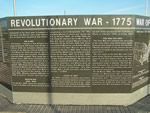
By 1835, approximately 15,000 settlers were in
Texas and most were in open rebellion against the ruling Mexican government.
On 10 Dec. 1835, after a short battle, 300 Texans captured 1,105 officers and men
of the Mexican army and the city of
San Antonio. On 3 March 1836, the Texans declared their independence and
the state, the “Republic of Texas”.
Sam Houston was appointed Commander of the Texas army. In response to this
threat, the Mexican army, under
General A.L. de Santa Anna marched on San Antonio.
The Alamo, a mission in San Antonio, was being defended by 183 Texans. From 23 Feb.
to 5 March 1836, the defenders withstood the attacks of the Mexican army of 3,000
men.
On 6 March the Alamo was overrun. The five surviving Texans were executed. The Mexican
army had 1,500 casualties. Three weeks later at Goliad, Texas, 300 Texans surrendered
and were executed by the Mexican Army.
Shouting, “Remember the Alamo and Goliad”, 600 Texans led by General Sam Houston
attacked the Mexican army of 1,250 men led by General A.L. de Santa Anna. The Mexican
Army was defeated at San
Jacinto, TX on 21 April 1836. Mexican casualties: 630 men and 700 prisoners.
Texans lost nine men.
MEXICAN WAR (1846-1848)
On 29 Dec. 1845, Texas was accepted as a state in the Union. U.S.
General Zachary Taylor established a fort at Brownsville, TX.
This prompted Mexico to declare war against the U.S. on 25 April 1846. On 13 May
1846, the U.S. Congress declared war on Mexico. On 8 May, U.S. forces attacked Mexican
troops at Palo Alto, TX.
By 28 Sept. 1846, U.S. forces had captured
Monterrey and Saltillo,
Mexico.
California and New Mexico
were also captured by the U.S. in 1847. After a series of fierce battles,
Mexico City surrendered to U.S. forces on 14 Sept, 1847. On 2 Feb. 1848,
Mexico formally surrendered to the U.S. in the “Treaty of Guadalupe-Hidalgo.”
By this treaty the U.S. secured the
Rio Grande (river) as its southern boundary, and Mexico gave up claims to
Texas, Arizona, New Mexico, Utah,
Nevada and part of Colorado.
U.S. KIA: 1,733; WIA 4,152 and other non-hostile deaths – 11,550.
FEARS OF WAR
By 1850, economic, political and slavery differences escalated between northern
and southern states raising the fears of war. After President Lincoln was
elected on 6 Nov. 1860, the first seven southern states seceded from the U.S. Union
and formed the “Confederate
States of America” (CSA) on 8 Feb. 1861.
The Civil War that followed the secession of the seven states often pitted family
against family as they fought to settle the question: “Would the Union of the United
States continue to exist or be divided into two countries?”
The first shots of the Civil War were fired when South Carolina bombarded and then
captured U.S. Fort Sumter,
N.C. on 12 April 1861. President Lincoln declared the secessionist states in rebellion.
The Civil War that followed this incident became the bloodiest war in American history
with over one million casualties.
On 18 March 1861, the first battle was fought at
Manassas, VA., between Confederate and Union forces outside Washington,
D.C. The battle ended with Union troops withdrawing and horrific casualties of 3,461
for both sides. The American Civil War had begun in earnest.
Wall 4: SELECTED CIVIL WAR BATTLES
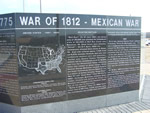
“Bull Run”-
On 21 July 1861, the Union army of 35,000 men attacked the Confederate army of 29,000
at Bull Run Creek near Manassas, VA. Union forces were defeated.
“Shiloh”- On 6-7 April,
1862 the Confederates attacked Union forces at Shiloh, TN. Each side suffered approx.
1,700 killed and 8,000 wounded. Hundreds died later from inadequate medical care
and infections.
Further east, General Thomas
“Stonewall” Jackson led his confederate force of 18,000 men into the
Shenandoah Valley attacking twice that number of Union troops. Union
General George McClellan
invaded
Virginia and fought Confederate
General Robert E. Lee in a number of battles including “Seven
Pines” (May 31) and “Seven
Days” (June 26-July 2, 1862). Outfought, McClellan withdrew
Union troops. General Lee moved his forces to Maryland and engaged in the
bloodiest single day of the war at
Antietam.
“Battle of Antietam” (Sept. 17, 1862) Union losses were 2,108 killed, 9,549 wounded
while the Confederates lost 2,700 killed and 9,029 wounded. After this bloody battle,
Gen. Lee withdrew Confederate forces to Virginia.
On 4 July 1863, General Ulysses
Grant, captured
Vicksburg, TN on the Mississippi river. This was a staggering blow to
the Confederates as it closed the Mississippi river to Confederate traffic and cut
off Texas, Arkansas, and Louisiana
from the rest of the Confederacy.
In the east, Southern General Lee again invaded the North on July 1-4, and fought
Union troops in the “Battle
of Gettysburg”, PA. Both sides suffered terrible losses in this three day
battle. Confederates: 28,063; Union forces 23,043. This was the costliest battle
in lives, of the war.
On 19 Nov, 1863 President Lincoln visited the Gettysburg battlefield cemetery and
delivered these words:
“…we cannot consecrate – we cannot hallow - this ground. The brave men, living and
dead, who struggled here, have consecrated it, far above our poor power to add or
detract…and we here highly resolve that these dead shall not have died in vain…and
that government of the people by the people for the people shall not perish from
the earth.”
On 9-10 March 1864, Ulysses
S. Grant became Lieutenant General and was appointed Commander of all Union
forces (approx. 533,000). General
Tecumseh Sherman was directed to attack
Atlanta, GA. Gen. Grant took the “Army of the Potomac” (125,000) to
attack Gen. Lee’s army (60,000) in VA. The Confederates and Union forces met in
the Battle of the Wilderness
on 5-6 May. Union casualties: 2,246 killed, 12,037 wounded and 3,383 missing. Confederate
casualties were estimated to be 8,000. By 8-12 May, both armies were reengaged in
battle at
Spotsylvania, VA. Often, the men were engaged in brutal hand to hand combat.
Both armies suffered approximately 12,000 casualties.
NAVAL BATTLE
On 5 August 1864, Admiral
David Farragut sailed his union fleet under the heavy Confederate cannon
fire to attack Mobile Bay,
AL. After an intense naval battle, Confederate forces surrendered, closing this
vital port to confederate supplies needed to sustain the troops in food and munitions.
ATLANTA, GA.
On 29 Aug. 1864, General William Tecumseh Sherman’s troops attacked Atlanta, GA.
After a savage fight, Confederate General
Hood surrendered Atlanta on 2 Sept. 1864. This Union victory helped propel
Abraham Lincoln, into his second term as President of the United States in November
1864.
MARCH THROUGH GEORGIA
After the battle for Atlanta, forces of General George Thomas’s
army pursued the Confederate army into Tennessee. General Sherman led the second
Union army and laid waste to Georgia. Union forces occupied Columbia, S.C. on 17
February 1864, burning over 1,700 stores, homes and buildings.
On 31 Jan. 1865, the U.S. Congress passed the
Thirteenth Amendment by 3 votes ending slavery. It was ratified by 27 states
on 6 December 1865. Slaves in America were officially freed.
The Confederate army without replacements, food, ammunition and surrounded on all
sides by Union forces, was faced with defeat.
Confederate General Lee met with Union General Grant in Willmer McLean’s farm house
at Appomattox Court House,
Pennsylvania. General Lee surrendered the Confederate army to General Grant on 9
April, 1865. The Civil War was over.
Wall 5: AFTERMATH OF WAR
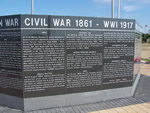
The American states had fought an ugly, bloody and horrific war suffering almost
one million casualties. Now the country was faced with rebuilding the lives of their
people and the states into one nation: “THE UNITED STATES OF AMERICA”.
PRESIDENT LINCOLN
On the night of 14 April 1865, President Lincoln was shot by actor
John Wilkes Booth. The President died on 15 April 1865. The nation suffered
and mourned a great President who had unwaveringly led the country through a terrible
Civil War and had sought an honorable peace for both sides declaring,
“with malice toward none: wth charity for all” .
1870’s - 1880’s - 1890’s
Following the Civil War, reconstruction of the South and gaining political control
became the dominant themes of the post war era. From the war years through 1890’s
growth of the country expanded greatly. Factories increased by 80% while 22,000
miles of railroad tracks were laid. On 10 May 1869, the Central Pacific and the
Union Pacific Railroads finally linked up at Promatory, Utah to connect the east
and west coasts of the U.S. Hundreds of homes, towns, cities and factories sprung
up along these railroad lines. During this period, thousands of immigrants continued
to pour into the western lands, displacing Indians. U.S. troops and settlers fought
the Indians for these lands. The U.S. population grew to over 50 million.
LITTLE BIGHORN
On 25 June 1876, General George
Custer led his U.S. Calvary forces against the Indian Nations on the Little
Bighorn River, Montana. His forces of 264 men were annihilated.
By 1886 the Indian Nations and wars were all but finished with most of the Indians
forced onto 170 Reservations provided for them in 21 states and territories.
SPANISH AMERICAN WAR 1898
On 15 February 1898, U.S.S.
Battleship Maine was blown up while anchored in the harbor of Spanish
controlled Havana, Cuba. Two U.S.
officers and 258 sailors were killed. Fueled by American newspapers, conditions
deteriorated between U.S. and Spain. U.S. Congress recognized Cuba’s independence
from Spain.
Spain declared war against the
U.S. on 24 April 1898. The U.S. declared war had existed between U.S. and Spain
as of 20 April, 1898.
PHILIPPINE ISLANDS
On the night of 30 April 1898,
Commodore George Dewey’s Asiatic Fleet steamed into Manila Bay,
to attack the Spanish Fleet. On l May, the U.S. Fleet destroyed Spain’s four war
ships, three torpedo boats and most of the shore artillery emplacements. In late
July, U.S. ground troops landed near the City of Manila meeting with little resistance.
Spanish troops surrendered on 13 Aug. 1898. U.S. casualties: none
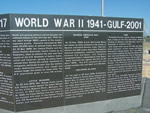
Following the U.S. forces victory in Manila Bay, troops of the U.S. 5th
Corps. began landing at Daiquiri and Siboney, east of Santiago in southern Cuba.
U.S. troops were led by the 10th and 19th black regiments,
1st Division troops and Teddy Roosevelt’s Rough Riders. On 1 July
1989, after intense fighting, the key hills, Kettle and San Juan overlooking the
City of Santiago, were captured by U.S. forces. On the night of 3 July, the Spanish
fleet sailed out of Santiago Harbor. The American naval fleet, in an approx. 3 hours
and 40 minute naval battle, destroyed or disabled five Spanish war ships. The Spanish
cruiser, Cristobal Colan, was driven aground by the U.S.S. Oregon’s 13-inch
guns.
On 17 July, 23,000 Spanish troops surrendered to U.S. forces. On 23 July, U.S. troops
invaded Puerto Rico against
little resistance by Spanish forces. By 16 Aug. U.S. forces had secured Puerto Rico.
On 10 December 1898, Spain and the U.S. signed a Peace Treaty. Spain gave up control
of Cuba, making it an independent state. Puerto Rico and Guam were ceded to the U.S. The
Philippine Islands were placed under the protection of the U.S. with a U.S. payment
of 20 million dollars for Spanish public property. U.S. War Deaths: 385 killed;
1,662 wounded: 2,061 died from tropical diseases & other causes.
Wall 7: CONFLICTS IN ASIA
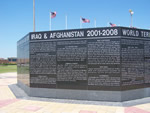
America’s new role as a global power led to two major conflicts in Asia at the turn
of the century. In 1899, an anti-foreign rebellion began in China and led to the siege of
diplomatic Missions in Beijing. The U.S. joined with forces from other nations,
put down the rebellion and by 1901 had freed the foreign Missions. In 1899 Filipinos
rose up in resistance to American occupation and carried on a conflict officially
lasting until 4 July 1902. Of the 126,468 U.S. troops who fought in this conflict,
1,020 were KIA and 2,930 were WIA.
In Europe, on 28 June 1914, Austrian’s
Archduke Ferdinand and his wife were killed by a Bosnian Serbian. This act
set off WWI (1914 – 1918).
Austria attacked Serbia while
Germany supported Austria. Before war’s end, 32 nations had joined sides
in this global conflict.
UNITED STATES ENTERS WWI
In Jan. 1917, Germany declared unrestricted
submarine warfare. In Feb. and March, six American vessels were sunk and
48 Americans lost their lives. On 6 April 1917, U.S. declared war on Germany and
its Central Powers. U.S.
military forces were referred to as the Army Expeditionary Forces (AEF). They arrived
in France in June, 1917.
AMERICA FIGHTS
By Oct. 1917, AEF had 5 infantry divisions and support units of approximately 1
million men in France.
The AEF fought its first battle on 28 May 1918, at the village in Cantigny, France.
At the end of May, AEF were blocking a major German attack on the road to Paris,
at Chateau-Therry, France. The German attack was stopped by AEF who suffered 1,600
killed and 2,513 wounded.
WAR CONTINUES
The first full American division fought as a complete force near the town of St.
Mihiel. On 12 Sept. 1917, U.S. and French troops, supported by 1,400 aircraft under
the command of U.S. General
William (Billy) Mitchell, attacked St. Mihiel. By 16 Sept. St. Mihiel was
under U.S. and Allied control. General
John Pershing commanding American forces with other Allied armies launched
the Meuse-Argonne offensive
on 26 Sept. 1918. The attack was supported with over 500 aircraft from the United
States Air Services. AEF had advanced 32 km when peace was declared.
WAR ENDS
Peace (Armistice) was signed
on 11 Nov. 1918, with unconditional surrender by Germany to the Allied forces.
AFTERMATH
4,734,991U.S. military troops served during WWI with approximately half in France.
The Navy had 500,000 with 78,000 in the Marines. Of the 2 million U.S. soldiers
to see combat, 53,000 were killed in action and another 55,000 died from diseases
similar to Spanish Flu. Over 200,000 were wounded including 50,000 gassed during
the war.
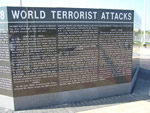
On 7 December 1941, the Japanese Imperial Fleet with 360 aircraft bombed and strafed
eight U.S. battleships, other vessels, U.S. troops and over 300 aircraft at
Pearl Harbor, Hawaii. On 11 December Germany and Italy declared war on the
U.S.
Before war’s end, 59 nations were engaged in this global war. After horrific military
and civilian casualties and catastrophic losses to overseas cities and countries,
German forces, unconditionally surrendered on 7 May 1945.
In the Pacific area, U.S. dropped two
atomic bombs on Japan at
Nagasaki (6 Aug.) and Hiroshima
(9 Aug.), 1945. Japan surrendered on 2 Sept. 1945. Total U.S. military served; 16,112,566.
The U.S. Deaths: 405,399, WIA, 670,846. Allied armies casualties: 13 million; German
casualties, 4 million. Thus ended the deadliest war in history.
KOREA
On 25 June 1950, Communist North
Korea attacked South Korea
across the 38th
parallel, dividing North and South Korea. U.S. had approx. 482 military
advisors in South Korea. U.S. and United Nations entered the fight against North
Korea and later against 400,000 Chinese volunteers who entered the war in Sept.
1950. Peace was signed on 27 July 1953.
2,834,000 U.S. troops served: 36,574 deaths: 103,284 wounded; 8,177 missing. Hostile
North and South Korean armies continue to face each other at the 38th
parallel (2008).
VIETNAM
The French and Vietnamese war ended on 21 July 1954. Vietnam was divided with the
North ½ to Communist Vietnamese with the South ½ to the Vietnamese Bao Dai’s Regime.
Insurgents supported by No. Vietnam attacked South Vietnam. By 1964 U.S. had 30,000
advisors in South Vietnam. In 1965 U.S. Divisions and support units begin arriving
in South Vietnam. As the war escalated, U.S. bombed cities and targets in North
Vietnam, Laos and
Cambodia. On 27 July 1973, American troops and equipment were withdrawn.
On 30 April 1975, South Vietnam surrendered to North Vietnam. U.S. Deaths; 58,220,
WIA; 303,644. Total U.S. and allied United Nation casualties: 1,772,473.
1970’s - 2008
During this period, U.S. had been militarily and diplomatically involved in Middle
East affairs. A few of these incidents included: Marine barracks bombed in
Beirut killing 299 Marines (23 Oct. 1983); U.S. Marines withdrawn from
Lebanon (26 Feb. 1984); U.S. Air Force bombed Libya (14 Apr. 1986);
Iraq
invaded Kuwait (2 Aug. 1990);
U.S. and Allies attacked Iraq inside Kuwait (16 Aug. 1991); In the U.S., the twin
towers buildings in
New York were destroyed and the
Pentagon (Washington, D.C.) was damaged by terrorists, (11 Sept. 2001);
U.S. Air Force bombed
al -Qaida and Taliban
terrorist camps in Afghanistan
(7 Oct. 2001).
U.S. and Allies attack Iraq (20 May 2003). U.S. and Allied forces remain in Iraq
and Afghanistan battling insurgency, terrorists and religious extremists. U.S. casualties
in Iraq and Afghanistan (Oct. 2001 - Oct. 2008); Deaths; 4,775 (114 females); WIA
33,216 (609 females). The war continues to date (2008)